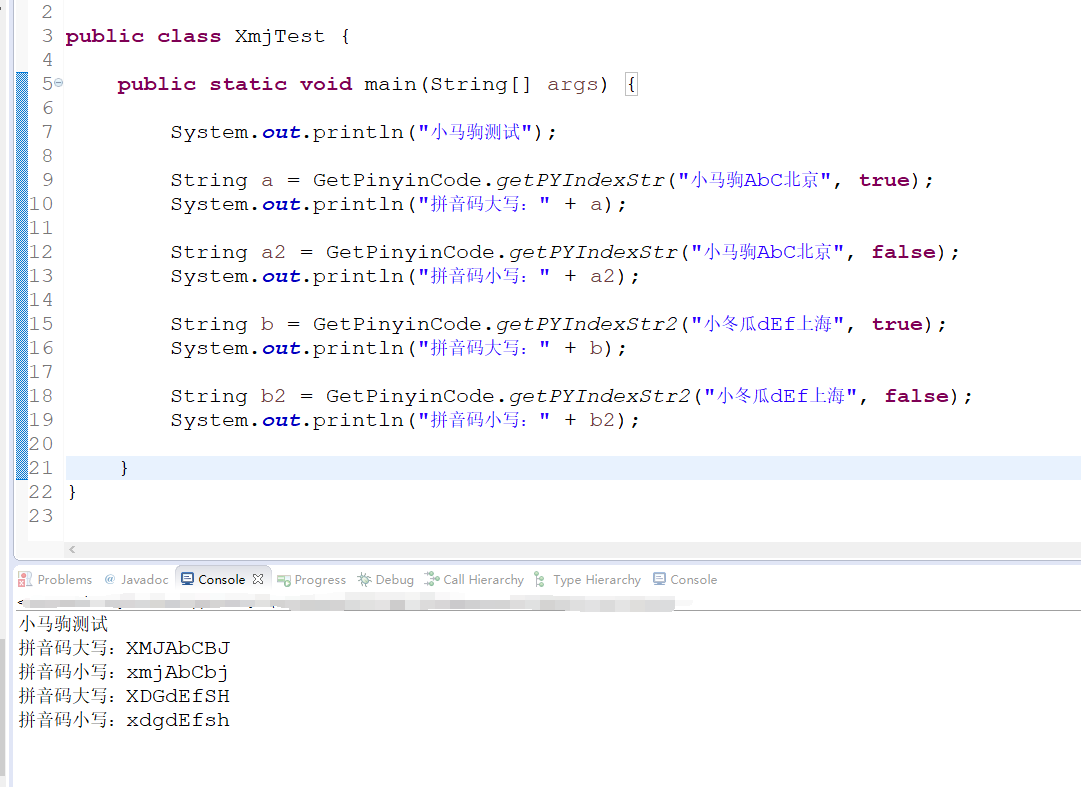Java获取汉字的大小写拼音码(汉字的拼音首字母)
import java.io.UnsupportedEncodingException; /** * 获取拼音码 * * @author xmj * */ public class GetPinyinCode { private final static char[] en_char_Upper = { 'A', 'B', 'C', 'D', 'E', 'F', 'G', 'H', 'J', 'K', 'L', 'M', 'N', 'O', 'P', 'Q', 'R', 'S', 'T', 'W', 'X', 'Y', 'Z' }; private final static int[] posValue = { 1601, 1637, 1833, 2078, 2274, 2302, 2433, 2594, 2787, 3106, 3212, 3472, 3635, 3722, 3730, 3858, 4027, 4086, 4390, 4558, 4684, 4925, 5249, 5590 }; private final static int[] posValue2 = { 45217, 45253, 45761, 46318, 46826, 47010, 47297, 47614, 48119, 49062, 49324, 49896, 50371, 50614, 50622, 50906, 51387, 51446, 52218, 52698, 52980, 53689, 54481, 55290 }; /** * 获取字符串的大小写拼音码,true为大写 * * @param strChinese * @param bUpCase * @return */ public static String getPYIndexStr(String strChinese, boolean bUpCase) { try { StringBuffer buffer = new StringBuffer(); byte[] b = strChinese.getBytes("GBK"); int i = 0; while (i < b.length) { if ((b[i] & 0xFF) > 128) { int char1 = b[(i++)] & 0xFF; char1 <<= 8; int chart = char1 + (b[i] & 0xFF); buffer.append(getPYIndexChar((char) chart, bUpCase)); } else { char c = (char) b[i]; if (!Character.isJavaIdentifierPart(c)) c = '?'; buffer.append(c); } i++; } return buffer.toString(); } catch (Exception e) { System.out.println("取中文拼音有错" + e.getMessage()); } return null; } /** * 获取字符 * * @param strChinese * @param bUpCase * @return */ private static char getPYIndexChar(char strChinese, boolean bUpCase) { int charGBK = strChinese; char result = '~'; if (charGBK > 45216 && charGBK < 55290) { for (int i = 0; i < 23; i++) { if (charGBK >= posValue2[i] && charGBK < posValue2[i + 1]) { result = en_char_Upper[i]; break; } } } if (!bUpCase) result = Character.toLowerCase(result); return result; } /** * 获取字符串的大小写拼音码,true为大写 * * @param str * @param bUpCase * @return */ public static String getPYIndexStr2(String strChinese, boolean bUpCase) { if (strChinese == null || strChinese.trim().length() == 0) { return ""; } String result = ""; for (int i = 0; i < strChinese.length(); i++) { try { result = result + getFirstLetter(strChinese.substring(i, i + 1), bUpCase); } catch (UnsupportedEncodingException e) { e.printStackTrace(); } } return result; } /** * 取得给定汉字的首字母,true为大写 * * @param chinese * @param bUpCase * @return * @throws UnsupportedEncodingException */ private static String getFirstLetter(String strChinese, boolean bUpCase) throws UnsupportedEncodingException { if (strChinese == null || strChinese.trim().length() == 0) { return ""; } strChinese = new String(strChinese.getBytes("GB2312"), "ISO8859-1"); if (strChinese.length() > 1) { int ch_area_code = (int) strChinese.charAt(0) - 160;// 汉字区码 int ch_bit_code = (int) strChinese.charAt(1) - 160; // 汉字位码 int ch_code = ch_area_code * 100 + ch_bit_code; // 汉字区位码 if (ch_code > 1600 && ch_code < 5590) { for (int i = 0; i < 23; i++) { if (ch_code >= posValue[i] && ch_code < posValue[i + 1]) { char a = en_char_Upper[i]; if (!bUpCase) a = Character.toLowerCase(a); strChinese = String.valueOf(a); break; } } } else { strChinese = new String(strChinese.getBytes("ISO8859"), "GB2312"); strChinese = strChinese.substring(0, 1); } } return strChinese; } }
测试一下



